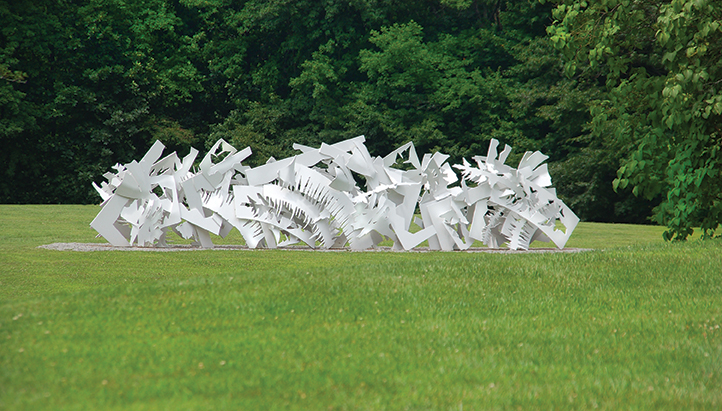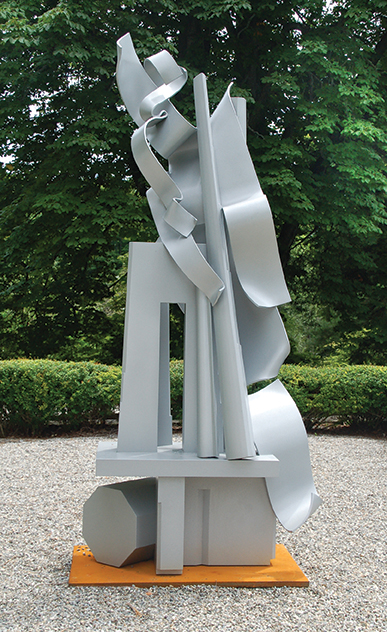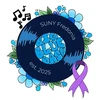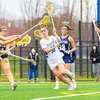 |
Fredonia’s In Sight/On Site program will bring two contemporary sculptures to campus in 2015 — one by an artist who presents an environmental critique in most of his works, and the other from an artist of international stature who previously worked with Marion Art Gallery Director Barbara Räcker.
Steven Siegel, who utilizes pre-consumer and recycled materials such as crushed soda cans, empty milk containers and shredded rubber, will be assisted on site by Fredonia students in the sculpture creation, “We are the Landscape,” during the spring semester. The visit will mark a return to Fredonia for Siegel, who created “Warm Up,” a structure of tightly bound newspapers, in 2001.
“We wanted him back because he worked so well with students to create a sculpture. Even though it was made of paper, it lasted six years,” Ms. Räcker said.
Siegel, who has an M.F.A. from Pratt Institute, has created largescale outdoor works at more than a dozen colleges and universities across the United States, in addition to installations across Europe and elsewhere in North America. Large boulders made out of compressed cans and plastic bottles and multiple layers of newspapers have been credited with an awakening of an awareness of the scale of consumer waste in a beautiful, integrative way. Siegel is based in Red Hook, N.Y.
In the fall, the campus will welcome a metal sculpture — and so much more — from Albert Paley, an internationally renowned sculptor. In a career spanning more than 40 years, Mr. Paley has completed more than 50 site-specific structures — often made of bronze and weathering steel — that have been placed in high-profile locations such as the Renwick Gallery of the Smithsonian Museum in Washington, D.C., New York State’s Senate Chambers in Albany and the Rochester Institute of Technology (RIT). His latest major project featured 13 newly executed sculptures on Park Avenue in New York City.
Several members of Fredonia’s Art Forum, the student group that directs In Sight/On Site, along with Räcker, toured Paley’s Rochester studios in November and selected three candidates for the campus placement.
There will also be a showing in the Marion Art Gallery of preliminary models, or maquettes, and drawings that depict the processes Paley uses to create his works as well as large photos of some of his larger installations.
“His work is a good springboard to talk about the creative process, since he creates cardboard maquettes, larger steel maquettes and drawings, in addition to the final massive sculpture. We will have drawings and maquettes in the gallery exhibition of whatever sculpture is chosen for In Sight/On Site,” Räcker explained.
Räcker worked with Paley on a 65-foot sculpture, “Hallelujah,” which was commissioned for the Clay Center for the Arts and Sciences in Charleston, W.Va., where she previously served.
Paley is the first metal sculptor to receive the coveted Institute Honors from the American Institute of Architects, the highest award AIA gives to a non-architect. He has the rank of Distinguished Professor and holds an endowed chair at the College of Imaging Arts and Sciences at RIT. He earned an M.F.A. from the Tyler School of Art in Philadelphia and has been awarded four honorary doctorates.
 The In Sight/On Site program was created in 1998 by SUNY Distinguished Teaching Professor Robert Booth, chair of the Department of Visual Arts and New Media, and now-Emeritus Distinguished Teaching Professor Marvin Bjurlin, in collaboration with then-President Dennis Hefner to present contemporary sculpture to the campus and surrounding communities in public spaces. Sculptures are typically placed here on a rotating basis, often for three years. Several installations, such as “Popeye,” the intertwining steel spirals adjacent to Rockefeller Arts Center, have become permanent campus fixtures. Buildings and Grounds staff members assist with site preparation and installation.
The In Sight/On Site program was created in 1998 by SUNY Distinguished Teaching Professor Robert Booth, chair of the Department of Visual Arts and New Media, and now-Emeritus Distinguished Teaching Professor Marvin Bjurlin, in collaboration with then-President Dennis Hefner to present contemporary sculpture to the campus and surrounding communities in public spaces. Sculptures are typically placed here on a rotating basis, often for three years. Several installations, such as “Popeye,” the intertwining steel spirals adjacent to Rockefeller Arts Center, have become permanent campus fixtures. Buildings and Grounds staff members assist with site preparation and installation.
Art Forum has funded the program for many years through its Student Association allocation, said Mr. Booth, who remains associated with the program as a member of all installation teams as well as an advisor and informational resource. An additional grant from the Carnahan-Jackson Humanities Fund will help support the Siegel sculpture and residency.
“People of all backgrounds seem interested in outdoor sculpture, or have an opinion either way,” Räcker noted.



